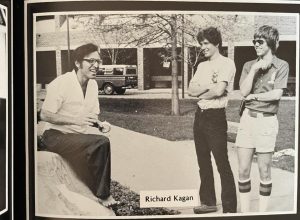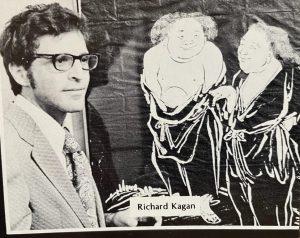I entered the classroom as a minister of education. My purpose was not to teach canonical texts which students would memorize to fill up their mental piggy banks. (John Dewey) waiting to spend them on grades and graduation. I knew most of my students took my course to fill a requirement. They read the text, wrote short papers summarizing articles they had read or lectures they had heard, and studied for the exam to get a passing grade.
The struggle to teach traditionally vs. the struggle to teach with a different pedagogy
Instead, I wanted to provide my students with the opportunity to discover and enjoy themselves while creating a foundation for their future pursuits. In one briefing I gave to the freshman class, I opined that no matter their major, they were citizens being prepared to apply themselves to such tasks as serving on boards of education, City Councils, philanthropic organizations, government councils, international diplomacy, and maybe marriage and children. College provided a protected place for learning to live your own life in a world that is complex, constantly changing, and at times threatening. One needed to escape after graduation with intellectual ammunition and self-esteem.
My freshman course, entitled Historical Evidence and Analysis, previewed this approach to teaching.
I began my classes with instructions on how to read a book. For instance, begin with the author’s credentials, the nature of people he or she acknowledges for helping research the text, and the Index where one can find some familiar references. This will help the student read the relevant pages to pass a judgement on the scope and reliability of the book’s content. Footnotes are a must. How often is one work cited. What is the texture of the references in terms of gender, sophistication, use of foreign languages, government documents, interviews, etc.
Many of my students informed me that the main lesson of my classes was how to read no matter what the topic.
Not so well received were my instructions to study the designs for the covers of the book, its title, and the smells, if an antique. In a Los Angeles bookstore (where else?) books were arranged by the colors of their bindings. Rather than using the categories of the Dewey Decimal system or arrangement by topics, the store revealed that the colors were as important as the titles themselves. The colors were equally relevant to the title of the material. I emphasized that the color yellow indicated books of little academic value. I presented them with a detailed examination of the historical use of this color to represent inferiority– yellow cabs, yellow phone books, yellow badges, yellow races, yellow turbans, yellow journalism.
One student tramped to the Dean’s office complaining. “I am not spending thousands of dollars in tuition to be told about the colors of books. And I like yellow!”
To make my point I required them to make a cover that identified my class, with an explanation of their colors, their title, and relevant descriptive information. Later this skill helped them in designing posters for meetings and even demonstrations.
In every course I taught the nature of language meanings and origins. For instance, I took time to lay out the social and religious reasons for changing the classification of quadrupeds to mammals. In the 17th century the nature of women was more closely defined. They were childbearing housewives. An artistic expression with a statue in the Louvre of a woman with a large handful of breasts waiting inevitably for a batch of babies artistically symbolized this status of women. (My lecture was based on a research article from a history journal which I shared with the class.)
My teaching assistant was in my office when the Dean forwarded a complaint to me that I was infatuated with breasts. The complaining student expressed her uncomfortable embarrassment. My T.A., a buxom blonde reached down to her sweater pulling it nearly over her head exclaiming that I never took any interest in her breasts. Fortunately, my office door was shut, and the windows too high for witnesses.
The problems of communication through language obligated me to stress the meanings and nuances of words. My favorite example was “Imperialism.” I asked the students to discuss the meaning of the term in examples from the Spanish-Portuguese, French, German, Marxism, British and American English. They were rightfully frustrated with this handful of language thistles. I proposed this exercise to remedy the dogma of believing in just one meaning of an idea regardless of its cultural and intellectual context.
To match my antipathy to the standard role of the professor, I often did not provide a syllabus for which I was nearly terminated. Only a legal issue prevented the punishment. In my experience, few students read the document, even once. It was more of a reminder for the professor to keep up with covering reading assignments and providing dates of the tests, the writing projects, and the final. The latter were often announced anyway. I enjoyed the spontaneity. Like a performer, I paid attention to my audience.
I began each session with Canadian or Chinese exercises. Accompanying them with yelling in Chinese, Japanese, or Korean depending on the title of the course. I found it helped the students stay alert in the 45 minutes of the class. More important it taught them the sounds of each language which they often later used to recognize people who spoke Chinese, Japanese or Korean.
The effect of this was evident when one student told me “Yours is the only class I have never slept in.”
My courses were somewhat popular. There were students who did not want to become East Asia majors, because of the taint that they would be known as “Kaganites. During some semesters I taught a three hour
Thursday night class. On the Wednesday before Thanksgiving, I asked them if they wanted to attend. They voted to attend. My lectures were known to be rambling, yet full of information. One time, I believe I was suckered, when asked to discuss the Yangtze river. After about 15 minutes the class broke out in laughter.
In addition to class lectures, I organized many field trips: to the Minnesota Historical Center, to theater, to academic history conventions and panels. The purpose was to introduce a wide range of information, culture, and professional scholarship.
During my course on the Korean War, a field trip of over 100 miles took us to a rural home near Austin, Mn. The hillside homestead looked over the surrounding fields. Inside we met with the mother of an infamous Korean War veteran. He had defected to North Korea where he taught English and had other tasks. Due to a serious illness, he was one of the very few defectors who returned to his home. After recovering, he changed his name and found work in a neighboring state. His mother willingly filled us in on his life but did not reveal his pseudonym or his outstate residence.
The purpose of this trip was to humanize soldiers in the War, the wounded, survivors, and even defectors.
Of course, I was concerned about the nature of my teaching method. I requested an office hour with the crusty Professor of Psychology, Bud Herganhan, a specialist in educational psychology. I had prepared for this meeting by giving him evaluations from former students.
Bud startled me with his learned analysis. “Richard, there are two types of teaching One is the box where the student learns the material, seals it up, and proceeds to the next class. Yours is the arc, where the student learns to the top of the arch. But the real learning is in his later life when he becomes aware of the significance and application of what he learned. The University was less impressed with me, the iconoclast, than the students. When I was up for tenure, it appeared my chances of achieving this goal were limited. Many of the students signed a petition supporting me. I did get tenure.
Despite many complaints about my unorthodox teaching and student complaints, I was promoted to Professor Emeritus.
Soon after the administration canceled my classes on historical method and discharged my East Asian studies major.
I can confidently state that in today’s climate I would not last an (explicative) semester.





Wow, wish I had been in your class Richard!
Altho this old librarian is not happy about books classified by the color of their covers!
Dear Dana:
My reasons for using this example were to portray the history of covers and deigns in books on Taiwan that chose grey covers with no design under martial law; Chinese reds and Chinese art, monuments, and government buildings under the nationalistic/pro China government; and colorful designs of Taiwanese life styles with human figures.
When the Naval Institute Press (USA published a book on a nationalist Taiwan President, the cover was grey with a battleship that was under the picture of the President. At first there was no chapter in the book about the military. The Press ordered the author to add such a chapter. It was an inadequate chapter. Yet the cover suggested the President’s military role was important. The Press is from the U.S. Naval press whose policies supported the Nationalist cause.
Two books on the independece leader had positive narratives showing him pulling rice out the fields, and the pro Nationalist narrative showing a wild face with its mouth open in protesting crowd.
One can see similar examples in books on history, political science, etc.
I wanted to shock them with the notion that book covers mattered. In many cases it worked. I had fantastic covers for their final assignments.
Richard, you describe your unique methodology for teaching the value of critical thinking, something your students may not have appreciated at the time, but would be of value for the remainder of their lives. You introduced them to unique ideas (the meaning of colors for bookbindings), learning to distinguish between different Asian languages (which might sound similar to our Western ears), and other interesting topics. How marvelous that the students rallied for you to get tenure! That shows how much they came to value you. Bravo!
I respect how you lived your values and transmitted them to your students.
It sounds like you made your classes unusually interesting. Most of mine were not.
Except for those taught by a certain English professor, who made freshman Comp so fascinating that I wound up using all of my non-science electives taking his graduate courses for undergrad credit. An odd experience at 20.
Richard, from one academic to another, I applaud your holistic approach to teaching and your unique and ingenious exercises for students. I also must say that in 40 years of college teaching, I’ve never had a student tell me that mine was the only class in which he/she never fell asleep. Sadly, I remember too many who did!